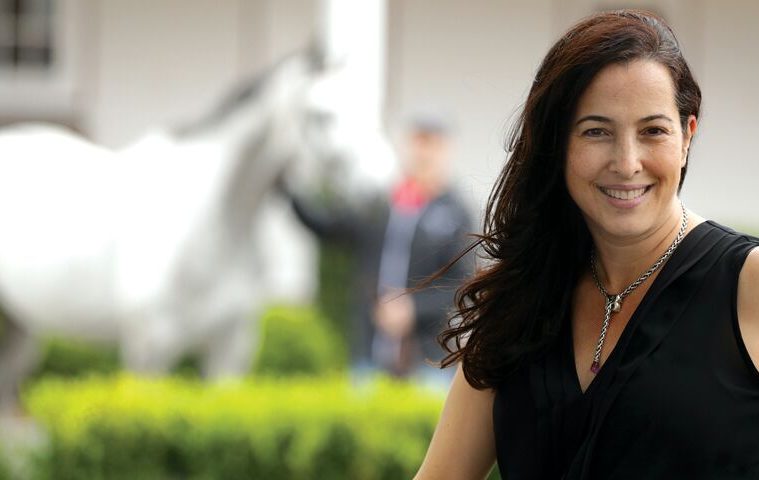Photo: George Kamper for Equestrian Living.
(Published 2017)
What is your personal history with horses? Did you start riding as a kid?
I grew up riding. I have a twin sister, and the two of us rode. We were those kids who, if we went to a party with a pony ride, we’d do it, and then go to the back of the line and do it over and over. We were obsessed. When we were six, my mom finally caved, and we started riding lessons. We began riding with Kris Ward, show jumper McLain Ward’s mom, when we were eight and rode with her until we went to college. I did the ponies, and by age 12 I moved up to horses and did the junior hunters and equitation. While at Mount Holyoke College, I rode on the equestrian team and com-peted in International Student Riding Association events and ended up running the U.S. organization for 10 years. I still ride for recreation, but I haven’t competed in many years.
How did you become involved with the Hampton Classic?
Tony Hitchcock and Jean Lundgren, a married couple, were the execu-tive directors of the classic for about 30 years. After the 2004 show, they decided to retire, and the board started the process to find a new executive director. I had worked with Tony a little on the national horse show, and he asked if I was interested in applying. I was running my own event-marketing business at the time, but the Hampton Classic had always been my absolute favor-ite horse show, so I decided it was the perfect combination of what I wanted to do and what I was doing. It was a long process of inter-views, but I was offered the position in July 2005. Tony and Jean stayed through March 2006 to help with the changeover period. I technically started just before the 2005 horse show and shadowed them and learned from them during the show. It was helpful in making a smooth transition. They are still here every year and a part of the Hampton Classic family.

What is your primary role as executive director?
I oversee all the different elements of the show, but I have a really great team of people who take on huge chunks of it. We work with the town on our event permits and on the contracts with all of the vendors. A big part of my job is working with sponsors. I work closely with my marketing director, Reyna Stein, in making sure we deliver what we promise from a branding standpoint and hospitality and being responsive to their needs. In the last few years we have had more than 100 corporate sponsors.
What are the challenges of setting up the show each year?
We start construction about four weeks ahead. We have very little permanent infrastructure, so every-thing has to come in—the tents, the grandstands, the stabling, the bleachers, the Jumbotron, and all of the shopping areas. Most of the competition rings are grass and that takes a lot of year-round main-tenance. There are more than 80 shops around the grounds, ranging from vendors selling apparel, jewelry, saddle, and equestrian products to a variety of food vendors.
What is the role of the classic’s horsemen’s advisory committee?
We have a really robust horsemen’s advisory committee that we rely on to give feedback and advice. For example, the prize money for the grand-prix qualifier this year is going from $75,000 to $86,000, and the reason behind this is the committee noted that riders would get higher bonus points in Fédération Equestre Internationale (FEI) world ranking if it was $86,000 or more. Things like that come up all the time because they are out there in the horse world, and that has a direct impact.The grand prix is at $300,000, which started in 2016. We try to offer good prize money to attract the best riders and their top horses. We want the best sport we can, and that’s part of what plays into it.
What makes the Hampton Classic such a unique event?
One of the things that makes the classic unique is that we attract an audience that’s not just horse people. It gives the event an excit-ing feel. On grand-prix Sunday, the grandstands and VIP tents are packed, but during the jump-off you can hear a pin drop, and then the crowd goes nuts. We’ve had 12,000 people on the grounds on grand-prix day. We also consistently have big crowds in our outer rings.
What is the economic and charitable impact of the classic?
The classic is a nonprofit, and we support charities that either have a tie to the sport or to the Hamptons. We support Southampton Hospital, that is our official community partner, and generally donate about $100,000 each year. We’ve donated to about 100 other charitable events each year. We help the Sag Harbor food pantry in a fun way. If people bring three or more food items to donate on Tuesday or Wednesday, their carload gets in free. Monday is rescue adoption day, where orga-nizations bring animals—dogs, cats, rabbits, even horses—for adoption.
Want to talk about Hollywood in the Hamptons?
Having so many celebrity attendees has just sort of happened. Often it’s because their kids ride. We gener-ally don’t know who is coming in advance. Jennifer Lopez came a few years ago, and we didn’t know she was coming. I also think they come here because it is common in the Hamptons to see famous people, so they aren’t harassed here.
Do you have accommodation suggestions other than house rentals?
Housing accommodations are our single biggest challenge. There are a few hotels, such as the Atlantic Southampton Ho tel, Southampton Inn, Sag Harbor Inn, Baron’s Cove, and Topping Rose House. It really depends on your budget. It’s Labor Day weekend in the Hamptons, so it’s a very busy time. I tell people to check our website for hotels, homes, and to try Airbnb.
tel, Southampton Inn, Sag Harbor Inn, Baron’s Cove, and Topping Rose House. It really depends on your budget. It’s Labor Day weekend in the Hamptons, so it’s a very busy time. I tell people to check our website for hotels, homes, and to try Airbnb.
What are some of your favorite local places to dine or visit?
East Hampton Grill is my favorite. Their grilled artichokes are out of this world, and the French dip is amazing. Almond (see page 108) in Bridgehampton is another favorite. I love the Brussels sprouts salad. Going to Wölffer Estate Vineyards is one of my favorite things to do when I have houseguests. We get some wine and a cheese plate and overlook the vines, and it’s just stunning. We also take house guests on a sightseeing boat tour that leaves from the wharf in Sag Harbor. There’s also the Sag Harbor Customs House next to the Sag Harbor Whaling Museum.


